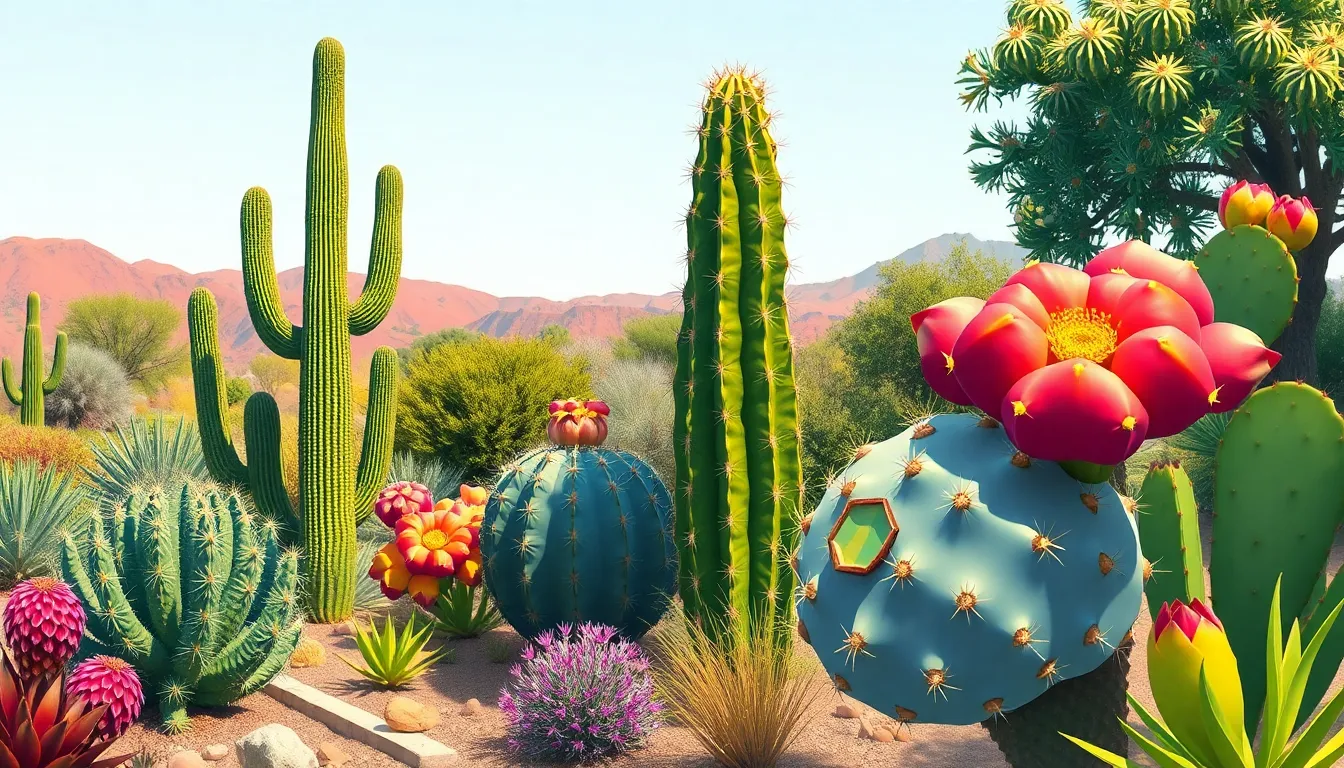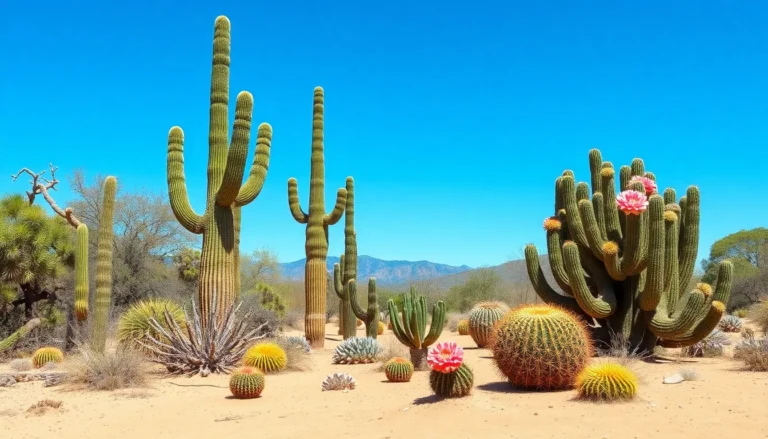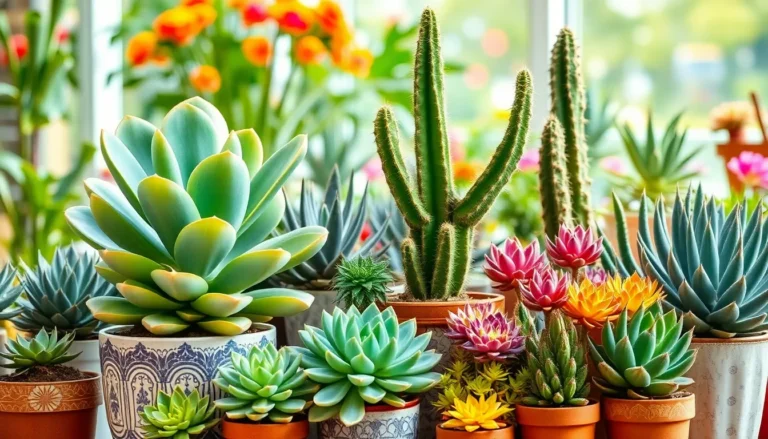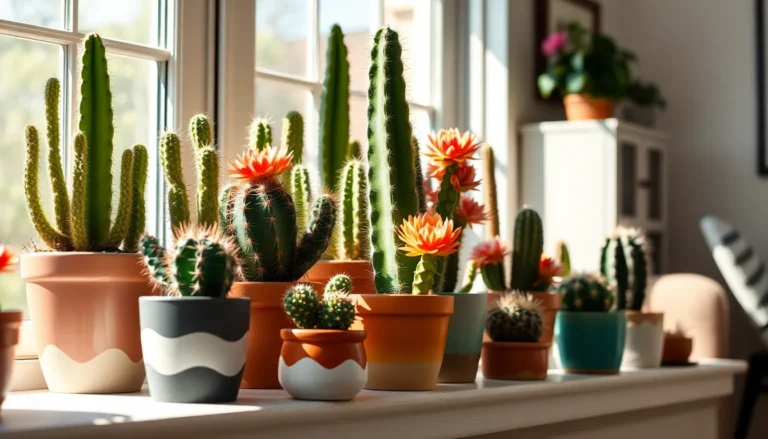Cacti are the ultimate survivors of the plant kingdom, thriving in the harshest conditions while looking fabulous. With their quirky shapes and vibrant colors, these spiky wonders can turn any dull corner into a desert oasis. Who wouldn’t want a plant that practically begs for neglect?
From the towering saguaro to the charming little bunny ears, cacti come in all shapes and sizes, each with its own personality. They’re like the introverts of the plant world—low maintenance and quietly impressive. Whether you’re a seasoned plant parent or just looking to add some character to your space, exploring the different types of cacti can be a fun adventure. Let’s dive into the prickly yet delightful realm of these fascinating flora and discover which one will steal your heart (and maybe a finger or two).
Different Types Of Cacti
Cacti exhibit a wide range of varieties, each with unique characteristics. Many people recognize the iconic Saguaro cactus, known for its tall, tree-like structure that can grow up to 50 feet high. These giants thrive in the Sonoran Desert and provide habitat for various wildlife, including birds and small mammals.
Another popular type is the Prickly Pear cactus, which features flat pads and colorful fruit. This species not only beautifies gardens but also offers edible fruits, commonly used in jams and beverages. The pads can be cooked or pickled, adding versatility to its appeal.
The Barrel cactus, characterized by its rounded shape and spines, often stands as a striking focal point in xeriscapes. Some varieties can store large amounts of water, making them particularly resilient in dry environments. They often produce vibrant, trumpet-shaped flowers that attract pollinators.
Exploring the Easter Lily cactus reveals its stunning white blooms that emerge in spring. This species thrives in rocky, arid landscapes and requires minimal care. Its striking flowers and sturdy nature make it a favored choice among enthusiasts.
The Christmas cactus, with its flat segments and colorful blossoms, brings festive cheer. This type blooms during the holiday season and often requires more humidity compared to traditional desert cacti. It blooms in shades of pink, red, or white, enhancing any indoor space.
Other notable types include the Fishhook cactus, renowned for its twisted spines, and the Cholla cactus, known for its segmented stems. Each variety offers distinctive growth patterns and adaptations for surviving in various habitats. Collectively, these cacti contribute to the rich tapestry of desert ecosystems and home gardens alike.
Popular Cacti Varieties
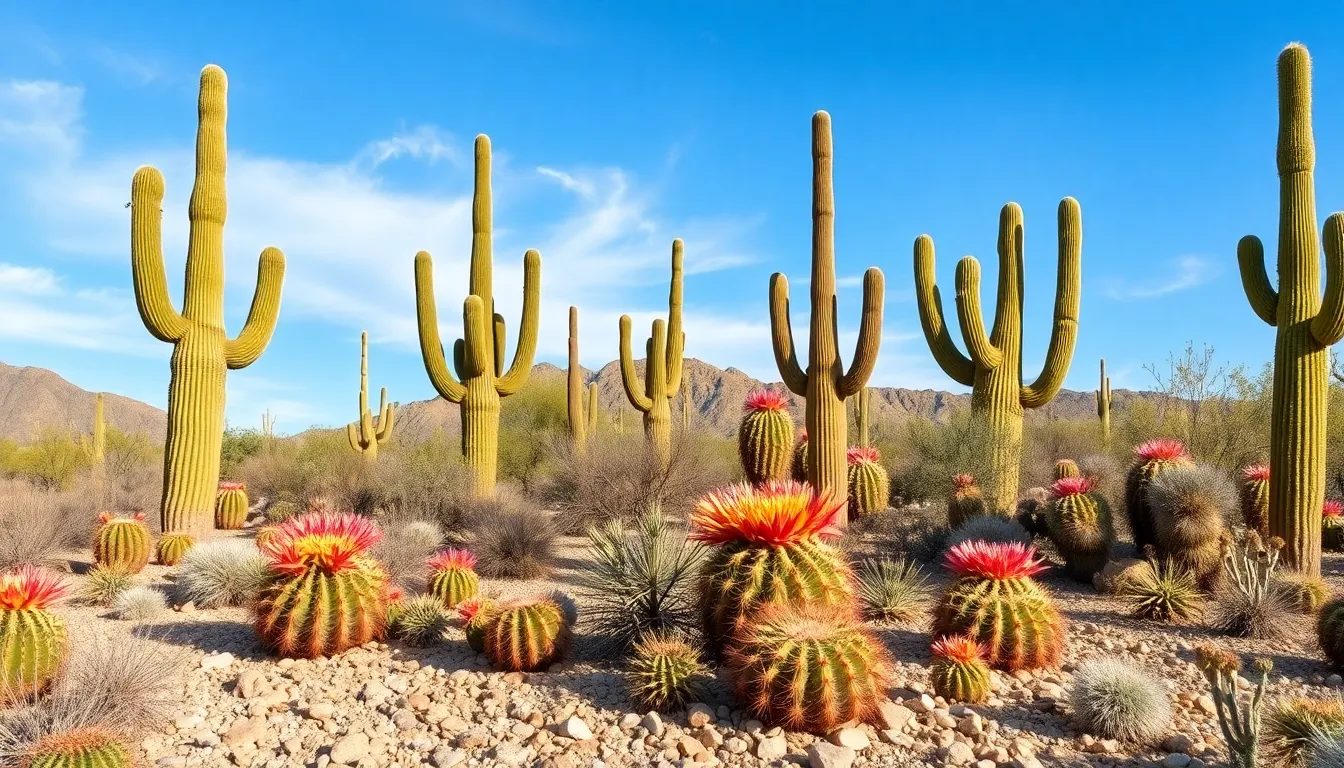
Several cactus varieties stand out due to their unique features and adaptability. This section explores some of the most popular cacti known for their distinct characteristics and appeal.
Saguaro Cactus
Saguaro cacti are iconic for their tall, upright structure, often reaching heights of up to 40 feet. These giants grow slowly, typically taking 50 to 70 years to reach full maturity. The Saguaro’s arms extend upward, creating a recognizable silhouette against the southwestern sky. In addition, it plays a crucial role in the ecosystem, providing habitat and food for various birds, mammals, and insects. Native to the Sonoran Desert, these cacti can live over 150 years, making them a long-lasting presence in their environment.
Prickly Pear Cactus
Prickly Pear cacti display flat, paddle-shaped pads that can range in color from green to deep purple. Each pad produces vibrant flowers in spring, followed by colorful fruits known as tuna, which are edible and commonly used in drinks and jams. They thrive in diverse conditions, from dry deserts to rocky hillsides. Their fleshy pads store water, allowing them to survive in arid climates. Additionally, Prickly Pears offer beauty while attracting various wildlife, enhancing the biodiversity of their habitats.
Barrel Cactus
Barrel cacti are easily recognized by their rounded, barrel-like shape, typically standing about 1 to 10 feet tall. These cacti often feature distinct ribs adorned with sharp spines, which help protect against herbivores. Some species produce stunning yellow or red flowers that bloom atop the plant during spring. Their capacity to store water makes them excellent drought-resistant plants for gardens. Growing in clusters, Barrel cacti contribute striking visual interest to desert landscapes and xeriscapes alike.
Unique Cacti Characteristics
Cacti showcase unique features that set them apart from other plants. Their size and shape variations, along with their colorful flowers, contribute to their distinctive appeal.
Size And Shape Variations
Cacti display a wide range of sizes and shapes, enhancing their visual diversity. The Saguaro cactus can soar up to 40 feet, creating a majestic presence in desert landscapes. Round forms like the Barrel cactus offer a compact option, perfect for smaller gardens. Various species, including the tall and slender Organ Pipe cactus, add architectural interest to outdoor settings. Additionally, the flat pads of the Prickly Pear cactus introduce a different texture, expanding design possibilities.
Colorful Flowers
Colorful flowers exhibit the beauty of cacti, attracting pollinators and adding vibrancy. The Easter Lily cactus produces striking white blooms, creating a stunning contrast against its green skin. Meanwhile, the Prickly Pear cactus showcases fruits called tunas that range from yellows to reds, further enhancing its visual appeal. Flowering periods may vary, with some cacti blooming in spring while others burst into color during the summer months. This floral diversity helps create a dynamic and ever-changing display in gardens.
Care Tips For Different Types Of Cacti
Caring for different types of cacti involves understanding their specific needs. Each variety thrives under distinct conditions, ensuring vibrant growth and longevity.
Light Requirements
Bright, direct sunlight suits most cacti species, fostering their rapid growth. Morning sun exposure can energize plants without causing stress. Some cacti tolerate partial shade, particularly during peak summer heat. Conversely, insufficient light can lead to elongated growth, weakening the overall structure. Observing plants for signs of inadequate light, such as pale coloration, aids in adjusting their position.
Watering Practices
Watering practices vary among cacti types, emphasizing the importance of proper techniques. Allowing the soil to dry completely between waterings prevents root rot, especially for species like the Saguaro cactus. Deep but infrequent watering ensures roots establish well. During the dormant winter months, reduce watering frequency significantly. Always adjust water levels based on environmental factors, like humidity and temperature, ensuring plants receive just what they require.
Soil Recommendations
Cacti thrive in well-draining soil, which minimizes water retention. Amend regular potting soil with sand or perlite to enhance drainage. Specific species, such as the Prickly Pear, benefit from a mix designed for succulents. A balanced pH, ideally between 6 and 7, supports healthy growth and root development. Regularly checking soil conditions allows for timely adjustments, promoting optimal health for all cacti.
Conclusion
Cacti offer a unique blend of beauty and resilience that can enhance any garden or indoor space. Their diverse shapes colors and sizes provide endless possibilities for creative arrangements. Whether one prefers the towering Saguaro or the compact Barrel cactus there’s a type to suit every preference and environment.
Exploring the world of cacti not only adds visual interest but also fosters a deeper appreciation for these remarkable plants. With minimal care requirements and striking features cacti are perfect for both novice and experienced gardeners alike. Embracing the journey of discovering different cacti can lead to a rewarding experience that brightens up any setting.

